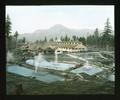Search
You searched for:
Start Over
Topic
Fish hatcheries
Remove constraint Topic: Fish hatcheries
Local Collection Name
Visual Instruction Department Lantern Slides, 1900-1940 (P 217)
Remove constraint Local Collection Name: Visual Instruction Department Lantern Slides, 1900-1940 (P 217)
Region
Cascade Locks >> Hood River County >> Oregon >> United States
Remove constraint Region: Cascade Locks >> Hood River County >> Oregon >> United States
1 - 2 of 2
Number of results to display per page
Search Results
- Description
- The output of our state hatcheries averages about 25,000,000 fry annually. Not only salmon, but trout and other food fishes are hatched and released into the streams. Salmon eggs and sperm are obtained from the adult fishes after they have ascended the smaller streams and the reproductive products are matured. Racks are constructed across the small streams and aginst these the fish crowd in the attempt to get by them. Here the fishes may easily be caught and the "stripping" process is carried out. By "stripping" is meant the extraction of the eggs and milt, or sperm, from the adults. The adult fishes are caught and by pressure of the hands the ripe eggs are forced from the female and the milt, or sperm, from the male. These products are then mixed in a container and fertilization soon occurs. Once fertilized, the eggs are placed in long, narrow troughs in the hatcheries. There are often wire bottomed trays to hold the eggs in the troughs. Water at low temperature is admitted at one end of the trough, circulates continuously over the eggs and escapes at the other end. The period of hatching requires from 35 to 70 days, different species requiring a different period of incubation. Conditions of environment will also alter this period. The care of the young after hatching under these artificial conditions is very important. Experimental work has been and is still being conducted to determine the best conditions under which the young will grow and thrive. The salmon when hatched have a yolk sack which they draw upon for food until it is completely absorbed, after which time they must be fed. It has been found that liver is one of the best foods for young salmon and cooked liver will cause them to increase in size and weight much faster than raw liver. It must be thoroughly powdered so that the small fishes can take it readily. Dried salmon or a mush are also used as food for the young fry. Milk curd has been found to be very good food. Lamprey Eels ground up and powdered are also used to some extent as food for young salmon. In previous years it was the custom to release the young from the hatcheries soon after the absorption of the yolk sack. At this period a very large percentage of them must have been destroyed by enemies long before they reached the sea. It has been found that the young fry have a much better chance of surviving if held in the hatcheries or in the ponds connected with them until the reach the length of four or five inches. This means holding and feeding them for a year or two after hatching. It makes it much more expensive, but insures a larger degree of success.

